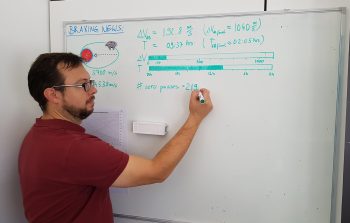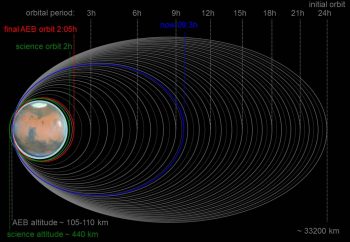
ExoMars Spacecraft Operations Engineer tracks TGO’s orbits
ExoMars has successfully performed a Flux Reduction Manoeuvre (FRM) for the first time. The manoeuvre was triggered by the excessive density of Mars’ atmosphere, which had slowed the spacecraft above the limit the operations team normally allows.
The manoeuvre happened on 19 September, just a month before ExoMars’ first arrival anniversary. (Editor’s note: Cool!)
FRM together with the so-called ‘Popup’ manoeuvre are the spacecraft’s automatic responses meant to save it from critical conditions that could cause damage, such as excessive heat or deceleration.
They both trigger the propulsion system to bring the spacecraft out of a current (problematic) orbit into a higher orbit. The FRM raises the orbit by just a little so that aerobraking can continue with reduced drag.
If circumstances become more severe, the spacecraft can automatically perform the ‘Popup’ manoeuvre. This operation brings the satellite into a much higher orbit and sets it into a special safe mode while aerobraking is interrupted. Luckily, so far, there has been no need for it to perform this manoeuvre.
Unfortunately, predicting the Martian atmosphere is very complex and conditions can change significantly from one orbit to the next, hence these automatic manoeuvres are maintained on-board by the team in case the spacecraft encounters a much denser atmosphere than expected.
When the spacecraft passes close to Mars, it measures the atmosphere and its effects on the spacecraft, subsequently transmitting the information to the flight controllers; note that atmospheric anomalies might occur depending on the local time of the Martian day or local topography (presence of mountains or valleys).
To maintain the window of acceptable atmospheric density, the flight dynamics team at ESOC routinely add commands for planned control manoeuvres. These slightly lower or raise the altitude of the atmosphere passage, the lowest part of the orbit (pericentre).

ExoMars Aerobreaking plan
Commanding of all of the manoeuvres is performed when the satellite is in the highest portion of its orbit (apocentre) because a manoeuvre always affects the altitude at opposite part of the orbit from where it is executed.
At the moment, every second day, a new set of commands must be uploaded to TGO’s schedule command buffer to cover activities in the next 10 orbits. ExoMars is currently on an orbit with a period of about 9 hrs and 30 mins, which will fall to 6 hrs by end of November.
Then, the challenges for the flight control team will become even more complex: flight dynamics will have to produce new commands and deliver these to the flight control team daily as the spacecraft will then be performing 4 orbits per day.
In 2014 Venus Express was the first ESA mission to perform aerobraking operations in order to gain experience in preparation for the ExoMars aerobraking phase. Unlike the Trace Gas Orbiter, Venus Express did not have the on-board autonomy like FRM to keep it safe even when ground controllers cannot react quickly enough.

Discussion: no comments